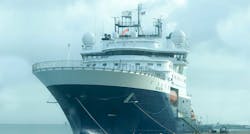The advent of the new year has brought cautious optimism to those concerned with the state of E&P in the US Gulf of Mexico.
In late December, Chevron sanctioned the $5.7-billion Anchor project in the Gulf, marking the industry’s first deepwater high-pressure development to achieve a final investment decision (FID).
Delivery of the new technology, which is capable of handling pressures of 20,000 psi, also enables access to other high-pressure resource opportunities across the Gulf of Mexico for the company and the industry, Chevron said.
The Anchor field is in the Green Canyon area, approximately 140 mi (225 km) off the coast of Louisiana, in water depths of about 5,000 ft (1,524 m). Stage 1 of the Anchor development consists of a seven-well subsea development and semisubmersible floating production unit (FPU). First oil is expected in 2024.
The planned facility has a design capacity of 75,000 bbl of crude oil and 28 MMcf/d of natural gas. Recoverable oil-equivalent resources are estimated to exceed 440 MMbbl.
Chevron, through its subsidiary Chevron U.S.A. Inc., is operator and holds a 62.86% working interest. Co-owner Total E&P USA, Inc. holds 37.14% working interest.
Steve Green, president of Chevron North America Exploration and Production, said: “For new projects in the Gulf of Mexico, we have reduced development costs by nearly a third, compared to our last generation of greenfield deepwater investments. We’re doing this by standardizing equipment, utilizing fit-for-purpose surface facilities that require less capital and employing drill to fill strategies. At Anchor, we streamlined our front-end engineering and design phase and are utilizing more industry standards in our designs and equipment to lower costs while maintaining operational excellence.”
Anchor is Chevron’s first greenfield FID as an operator since its sanction of Big Foot and Jack/St Malo in 2010.
Justin Rostant, an analyst with Wood Mackenzie’s Gulf of Mexico team, said: “Chevron’s sanction of the Anchor project shows that the US Gulf of Mexico still offers attractive investment opportunities for large greenfield developments. While over 80% of projects sanctioned in the last five years are shorter-cycle subsea tiebacks, standalone developments like Anchor are still able to compete for development capital. Anchor is the first of three 20-K projects that Wood Mackenzie expects to reach FID within the next 18 months. We estimate that these three projects combined hold approximately 1 Bboe in reserves and will require over $10 billion of capital investments.”
Then in January, Total E&P USA awarded Worley a front-end engineering design (FEED) contract for the North Platte field development in the Gulf. Located about 171 mi (275 km) off Louisiana, the North Platte field development includes a semisubmersible FPU in more than 4,265 ft (1,300 m) of water.
The project brings together Worley’s recently acquired capability for the FPU topsides design with INTECSEA’s experience for the design of the hull, mooring, and subsea pipelines. Worley’s expanded capability to deliver flexible FPU designs with capital efficiency and minimal time to market proved a key contributor to this award, the company said.
FEED is being led by the company’s Houston office with support from its Hyderabad office in India. The company completed the pre-FEED phase in August 2019.
North Platte requires the use of 20,000 psi technologies. The field development plan is based on eight subsea wells and two subsea drilling bases connected via two production loops to a newbuild, lightweight FPU. Production will be exported through existing oil and gas subsea networks. Oil production is expected to average 75,000 b/d at plateau level.
Total expects to make its FID in 2021. Total operates North Platte with a 60% working interest, alongside Equinor with 40%.
BSEE issues report on flowline jumper failure
The Bureau of Safety and Environmental Enforcement (BSEE) has released the panel investigation report on the October 2017 oil release located in about 4,463 ft (1,360 m) of water in the Gulf about 40 mi (64 km) southeast of Venice, Louisiana.
Over an approximate 24-hour period beginning the morning of Oct. 11, a fractured subsea wellhead jumper, that connected one wellhead to a pipeline end termination, released an estimated 16,000 bbl of oil into the Gulf.
As a result of its investigation into the incident and its findings, BSEE recommends that operators increase scrutiny in the design, placement, and maintenance of their subsea infrastructure. In particular, the report recommends careful evaluation of flowline components and surveying methods to ensure suitability and longevity.
The panel also outlined several recommended improvements in subsea leak detection including enhanced monitoring technology and additional training. •
About the Author
Bruce Beaubouef
Managing Editor
Bruce Beaubouef is Managing Editor for Offshore magazine. In that capacity, he plans and oversees content for the magazine; writes features on technologies and trends for the magazine; writes news updates for the website; creates and moderates topical webinars; and creates videos that focus on offshore oil and gas and renewable energies. Beaubouef has been in the oil and gas trade media for 25 years, starting out as Editor of Hart’s Pipeline Digest in 1998. From there, he went on to serve as Associate Editor for Pipe Line and Gas Industry for Gulf Publishing for four years before rejoining Hart Publications as Editor of PipeLine and Gas Technology in 2003. He joined Offshore magazine as Managing Editor in 2010, at that time owned by PennWell Corp. Beaubouef earned his Ph.D. at the University of Houston in 1997, and his dissertation was published in book form by Texas A&M University Press in September 2007 as The Strategic Petroleum Reserve: U.S. Energy Security and Oil Politics, 1975-2005.

